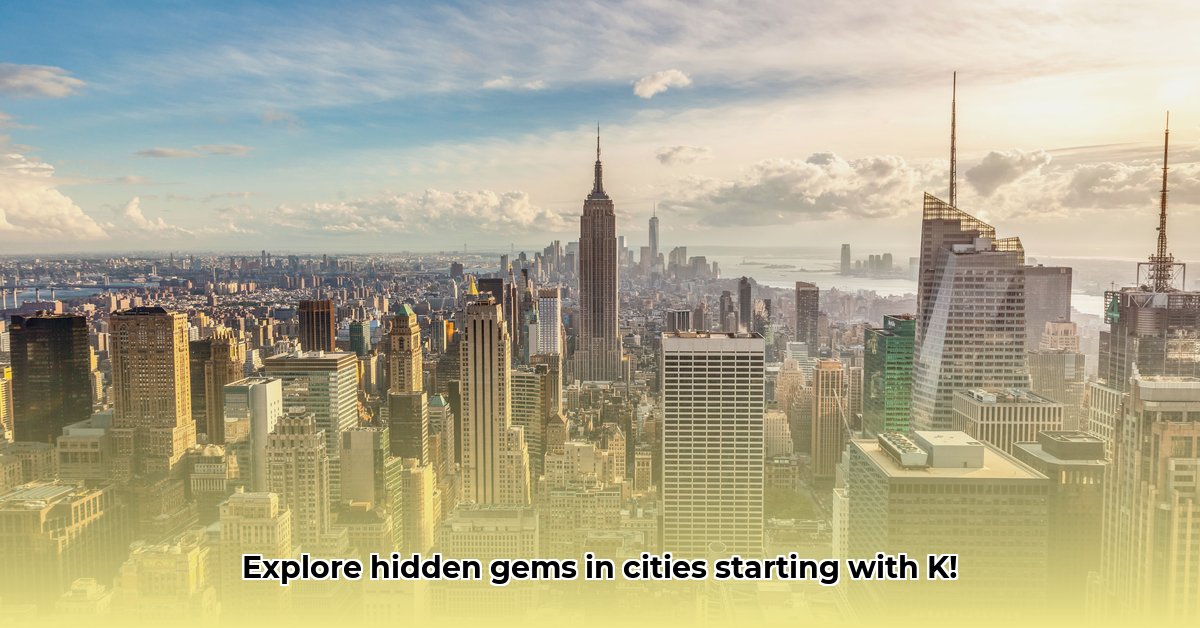Ever wondered what connects Karachi, a sprawling megacity, to Kyoto, a historic cultural center? Or how Kabul, a city steeped in history, compares to Kansas City, a major American hub? It’s all about the “K”—the letter that begins the names of cities across the globe, each with its unique story of growth, challenges, and cultural identity. This article takes you on a journey through a diverse group of “K” cities, looking at their populations, histories, economies, cultural scenes, and the innovative solutions they’re employing to address urban challenges. We’ll compare and contrast these cities, revealing the surprising similarities and differences in how these urban areas have developed and continue to evolve. Whether you’re a city planner, a curious traveler, or simply interested in global urban trends, you’ll discover valuable insights into what makes a city thrive—and what factors can lead to its challenges. Let’s explore the amazing world of K-cities together!
Cities That Start with K: A Global Exploration
Let’s embark on a captivating journey around the world to explore some remarkable cities, all sharing the unique characteristic of starting with the letter “K.” From ancient capitals brimming with history and cultural treasures to bustling modern metropolises showcasing cutting-edge innovation, these urban centers offer a captivating glimpse into how cities grow, adapt, and change over time. Their differences are truly remarkable, demonstrating the myriad ways human societies create thriving urban environments, while providing valuable insights into global urban development.
A World of K-Cities: Unique Urban Stories
Cities whose names begin with “K” provide a compelling lens through which to study the multifaceted nature of urban development. We’ll examine examples ranging from historical capitals steeped in tradition to rapidly expanding, modern-day giants grappling with contemporary challenges. Geographical location, pivotal historical events, and current economic landscapes all play crucial roles in shaping these cities. But what truly distinguishes these K-cities from one another? Let’s delve in and explore!
Consider Kabul, Afghanistan. Its history stretches back thousands of years, serving as a crossroads of civilizations. Its strategic location along ancient trade routes has profoundly influenced its growth, cultural diversity, and complex geopolitical landscape. Now, contrast that with Karachi, Pakistan – a sprawling coastal metropolis showcasing both the immense potential and the formidable challenges of incredibly rapid modernization and population growth. The contrast is striking! What makes these diverse urban landscapes so unique?
Understanding the Data: Navigating the Nuances
Obtaining accurate and consistent information about K-cities can indeed be a complex undertaking. Different international organizations and national statistical agencies may employ varying definitions of what constitutes a “city,” leading to inconsistencies in population figures, economic indicators, and other key data points. However, by carefully evaluating and cross-referencing multiple sources, we can still draw meaningful conclusions and discern valuable insights.
For example, the population sizes of these cities exhibit a dramatic range. Some are megacities with populations exceeding 15 million residents, while others are smaller urban centers with populations in the hundreds of thousands. This vast disparity underscores the diverse pathways of development and the varied scales at which these K-cities operate. Do these population variances significantly affect urban growth strategies and resource allocation priorities?
K-City Spotlight: A Closer Look
Let’s examine some specific K-cities more closely, highlighting their distinctive characteristics and unique contributions. It’s important to remember that population numbers are estimates, as data can be inconsistent across different sources and time periods.
| City Name | Country | Approximate Population | A Little History | Main Industries & Economy | What Makes It Special | Compared to Other Cities |
|---|---|---|---|---|---|---|
| Karachi | Pakistan | Over 15 million | Founded in the 1700s, it boomed thanks to British rule and its strategic port location. | Port activities, textiles, manufacturing, finance, and burgeoning tech sector. | A dynamic melting pot of cultures, but faces significant infrastructure and population management challenges. | Similar trajectory to other major Asian port cities, yet grapples with unique socio-political complexities. |
| Kolkata | India | Over 15 million | A city with a long and rich history as a major port under British rule; a vibrant center for culture, intellectual discourse, and artistic innovation. | Manufacturing, trade, finance, IT services – a crucial economic hub for eastern India. | A deep-rooted cultural heritage known for its arts, literature, film industry (Bollywood), and intellectual traditions. | Shares economic importance with Karachi but possesses a distinct cultural identity and historical significance. |
| Kabul | Afghanistan | Over 4 million | An ancient city with a history spanning millennia, a site of many pivotal battles, empires, and political transformations. | Relatively small industrial base, increasingly dependent on services, agriculture, reconstruction efforts, and international aid. | Significant historical and cultural significance, but faces daunting challenges related to security, poverty, and political instability. | Its historical weight and geostrategic importance stand in stark contrast to the rapid, often unplanned growth of other K-cities. |
| Krakow | Poland | Around 770,000 | A medieval city that has brilliantly preserved its historical architecture and cultural landmarks, weathering numerous wars and political upheavals. | Tourism, education, services, emerging technology sector, and a thriving cultural scene. | Beautifully preserved historical architecture, a vibrant cultural scene, and a growing reputation as a technology and innovation hub. | Its meticulously preserved past and growing modern economy set it apart from cities that have undergone more drastic transformations. |
| Kuala Lumpur | Malaysia | Around 1.8 million | A modern city experiencing rapid economic growth in the 20th and 21st centuries, strategically located as a key hub for trade and commerce. | Finance, tourism, trade, manufacturing, and a rapidly expanding technology sector. | A unique blend of diverse cultures, cutting-edge modern development, historical landmarks, and a thriving food scene. | Represents the dynamic urban growth and economic diversification seen in many Southeast Asian metropolises. |
Practical Lessons: Shaping Thriving Urban Futures
The diversity among K-cities underscores a crucial principle: there is no one-size-fits-all blueprint for building a successful and sustainable city. Urban planners, policymakers, and community stakeholders must carefully consider each city’s unique historical context, geographical characteristics, economic potential, cultural heritage, and social fabric. Access to reliable and consistent data is essential for conducting meaningful comparisons, identifying best practices, and making informed decisions. Governments, businesses, community organizations, and research institutions can all benefit from a deeper understanding of the unique needs, challenges, and growth trajectories of these diverse cities. Strategic investment in resilient infrastructure, sustainable urban planning initiatives, inclusive social programs, and proactive efforts to address inequality will be indispensable for fostering their long-term prosperity and ensuring a high quality of life for all residents. How can the implementation of sustainable practices enhance K-City economic prospects, improve environmental quality, and promote social equity?
How to Compare Sustainable Urban Development Strategies in Cities Starting with K
Let’s embark on a journey exploring globally diverse cities whose names begin with “K,” examining their unique and multifaceted approaches to sustainable urban development. How can we effectively compare these diverse strategies, taking into account their unique contexts and challenges? This requires a nuanced and comprehensive approach, considering a wide range of factors beyond merely technological advancements. We must analyze the complex interplay of economic, environmental, social, and governance aspects that shape each city’s path toward sustainability. What sustainable urban development approach is most effective in promoting long-term resilience, environmental stewardship, and social well-being?
Kazakhstan’s Capitals: Astana and Almaty – A Tale of Two Cities
-
Astana (Nur-Sultan): Known for its futuristic architecture, this meticulously planned capital, located in the expansive steppes of northern Kazakhstan, showcases a strong emphasis on modern design, technological integration, and ambitious urban development projects. Its rapid growth and increasing population density present both significant opportunities and formidable challenges in terms of long-term sustainability. The city’s reliance on energy-intensive infrastructure, including extensive heating and cooling systems to combat the harsh climate, is a particularly salient factor to consider when comparing it to other K-cities with milder climates and different energy needs. We can also critically analyze its ongoing efforts to improve public transportation networks, implement comprehensive waste management programs, and promote energy efficiency in buildings. How effective are these sustainability initiatives in mitigating the city’s environmental impact and enhancing the quality of life for its residents? What are the limitations of these approaches, and how can they be overcome?
-
Almaty: In stark contrast, Almaty, Kazakhstan’s former capital, nestled in the foothills of the Trans-Ili Alatau mountains, possesses a more organic and historically rooted urban fabric, characterized by tree-lined streets, Soviet-era architecture, and vibrant cultural traditions. Its development reflects a harmonious blend of historical preservation, cultural heritage, and contemporary growth. How to compare sustainable urban development strategies between these two distinct cities involves carefully analyzing their contrasting approaches to energy production and consumption, waste management practices, transportation systems, and approaches to preserving green spaces. For example, Almaty might be able to leverage renewable energy sources more readily due to its favorable geographic location and access to hydropower potential. Astana, on the other hand, may need to prioritize the adoption of innovative technologies and smart city solutions to enhance energy efficiency and reduce its carbon footprint.
Kenya’s Nairobi:
- Exotic Girl Names Reflecting Diverse Cultures And Unique Beauty - December 11, 2025
- Exotic Female Names Offer Cultural Richness and Unique Sounds - December 10, 2025
- Exotic Baby Girl Names Evoking Far-Off Lands and Beauty - December 9, 2025










